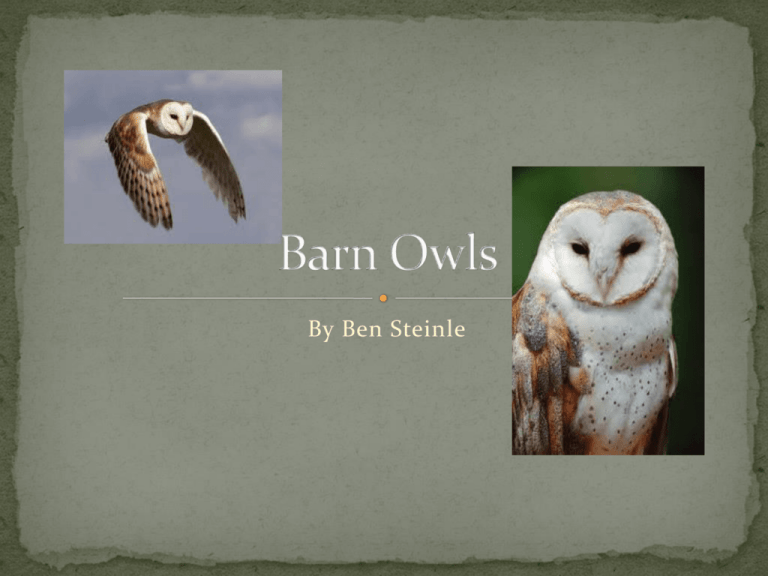Barn Owls - Local.brookings.k12.sd.us
advertisement

By Ben Steinle COMMON NAME: barn owl, golden owl, white owl, monkey-faced owl KINGDOM: Animalia PHYLUM: Chordata CLASS: Aves ORDER: Strigiformes FAMILY: Strigidae GENUS : Tyto (night owl) SPECIES: alba (white) The Barn Owl is found in virtually all habitats but much more abundantly in open woodland, heaths and moors than forested country. They usually roost by day in tree hollows but have also been found in caves, wells, outbuildings or thick foliage. Generally nocturnal, although it is not uncommon to see this species emerge at dusk or be active at dawn, occasionally being seen in flight during full daylight. Flight is noiseless, with wingbeats interrupted by gliding. The Barn Owl calls infrequently, the usual call being a drawn-out rasping screech. The courtship call of male at nest is a shrill repetitive twittering. Adults returning to a nest may give a low, frog-like croak. When surprised in its roosting hollow or nest, it makes hissing and rasping noises and snapping sounds that are often called bill snapping, but possibly made by clicking the tongue. The Upperparts are light grey with numerous fine dark lines and scattered pale spots on the feathers. There are buff markings on wings and on the back. The underparts are white with a few black spots, occasionally none. Feathering on the lower legs may be sparse. The heart-shaped facial disc is white with a brownish edge, with brown marks at the front of the eyes, which have a black iris. Its beak is offwhite and the feet are yellowish-white to brownish. Males and females are similar in size and color, females and juveniles are generally more densely spotted Barn Owls will breed any time during the year, depending on food supply. In a good year, a pair may breed twice. Rodent plagues cause Barn Owl numbers to increase dramatically. During courting, males may circle near the nest tree, giving short screeches and chattering calls. 3 to 6 eggs are laid (occasionally up to 12) at 2 day intervals. The eggs are 38 to 46mm (1.5-1.8") long and 30 to 35mm (1.2-1.4") wide and will be incubated for 30 to 34 days. Chicks are covered in white down and brooded for about 2 weeks, and are fledged in 50 to 55 days. After this, they will remain in the vicinity for a week or so to learn hunting skills and then rapidly disperse from the nest area. Young birds are able to breed at about 10 months. Barn Owls are short-lived birds. Most die in their first year of life, with the average life expectancy being 1 to 2 years in the wild. In North America the oldest known Barn Owl in the wild lived to be 11 years, 6 months. In Holland, a wild barn owl lived to be 17 years, 10 months old. In England, a captive female barn owl was retired from breeding at 25 years old Barn Owls specialize in hunting small ground mammals, and the vast majority of their food consists of small rodents. Voles (field mice) are an important food item, as well as pocket gophers, shrews, mice and rats. Barn Owls breed rapidly in response to mouse plagues. Other prey may include baby rabbits, bats, frogs, lizards, birds and insects. Prey are usually located by quartering up and down likely looking land particularly open grassland. They also use low perches such as fence posts to seek quarry. concave faces help channel sound into super sensitive ears and specialized feathers let owls fly under cover off darkness and without sound Female: Length 34-40cm (13.5-15.5") Wingspan 110cm (43") Weight 570g (20oz) Male: Length 32-38cm (12.5-15") Wingspan 107cm (42") Weight 470g (15.5oz) http://www.owlpages.com/owls.php?genus=Tyto&spec ies=alba









